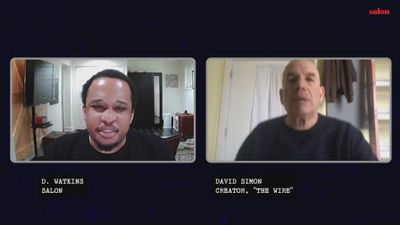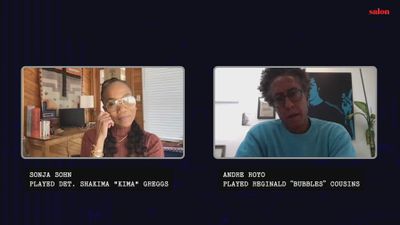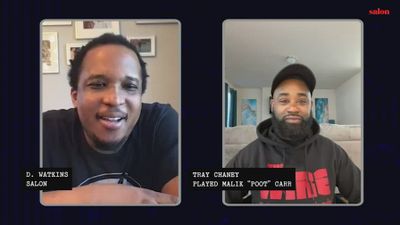All the pieces of "The Wire" still matter: From cops, corners and Omar to the systems that fail us - Salon
The history of cop television can be split into two biblical epochs: Before "The Wire" and After "The Wire." Sixty hours of a drama set in Baltimore, "that gave you all the realities of what was going on in Baltimore City," as actor Tray Chaney puts it, debuted on HBO on June 2, 2002, and changed how police were depicted on screen.
And it did so much more than that, too. To explore the many layers of "The Wire" and its impact on its audience, TV narratives, Baltimore and the individuals who made it, I interviewed a dozen creatives involved in making the series, including creator David Simon and many actors from the cast, including Andre Royo (Reginald "Bubbles" Cousins), Sonja Sohn (Det. Kima Greggs) and Chaney, who played the young dealer Poot in all five seasons of the series. This short documentary by Salon, "All the Pieces of 'The Wire' Still Matter," is the result.
We talked about what "The Wire" meant to them, what it was like to create and inhabit those memorable characters, and what they feel the legacy of "The Wire" is now, 20 years after its debut. We're still mourning the loss of Michael K. Williams, whose Omar Little remains one of the series' most indelible characters, but his thoughts on playing Omar— on being "in the deep end of the pool, emotionally" — from my 2018 "Salon Talks" interview are here as well.
"In the middle of shooting 'The Wire,' we ran into a lot of s**t," Royo told me. "First, it was the mayor, and he was saying that we were showing Baltimore in a bad light. Then there was the activists. Then there was people in general saying, 'Why do you show our neighborhood this way?'"
Before "The Wire"
Before "The Wire" I only remember hero cops. Or rather, I only remember seeing hero cops and their stories on film and TV. The police officers who worked in my neighborhood were anti-heroes; those guys couldn't wait to break their foot off in your ass for any and every reason. But cops were different in the movies marketed to '80s babies like me, in classics like "48 Hours" with Eddie Murphy, Arnold Schwarzenegger's "Kindergarten Cop," the "Die Hard" series starring Bruce Willis, the "Lethal Weapon" films with Mel Gibson and Danny Glover, "Beverly Hills Cop" with Eddie Murphy again — damn, Eddie was getting money in the '80s — and Laurence Fishburne's "Deep Cover."
Don't get me wrong — some of the cops in those films had a little edge to them. And there were shows that dabbled in police corruption narratives while exploring the idea of the imperfect hero; however, the protagonists were almost universally good. Not to mention handsome, funny, fit, hyper-heterosexual, loved their wives and would only bend the rules if it meant providing justice to their beloved citizens. I never met police like that, but Hollywood did. The cops who collectively tried to ruin my childhood were the opposite — they were rarely in shape and never made my block laugh with witty punch lines. They threw around racial slurs instead, and would bend the rules just because they knew they could get away with it.
RELATED: Thanksgiving and "The Wire": My true Baltimore story about the streets, writing and TV
I don't fault the actors, studio execs or even the screenwriters for how cops were portrayed then. In those days the wealthy didn't yell, "Black Lives Matter!" Diversity was not the initiative. And most of those people probably had great relationships with police officers — their cop stories probably involved an eager young officer helping them change a flat tire on a dark highway, or a veteran detective who took time out of his busy day to rescue their cat Marbles who got stuck in the sycamore tree. Or even the cop they called to investigate a crime who showed up at their home, took impeccable notes and then actually solved the crime.
There's no way the people who created those '80s and '90s cop stories had to deal with the kinds of officers that made it into my stories once I became a writer. Cops like Monkey Man, who would put your head through drywall before dangling you out of a window by your ankles. Cops like Bowling Ball, who loved to strip kids naked and pull off in the patrol car with all of their clothes. The worst was Fries the Devil, who had to crack you in the head because that was the only way he could have a good day. Those were the cops I knew. The cops I know. The personalities that never got airtime in the time known as Before "The Wire."
"We were trying to get an argument onto the op-ed page off of the entertainment page."
After "The Wire"
Now he's an award-winning TV executive and part-time Twitter assassin. But David Simon started out as a crime reporter for the Baltimore Sun. There he honed his skills as a newspaperman, learning to peel through the many layers of the onion that makes up Baltimore.
Crime in Baltimore, a city whose murder rate has been among the worst in the country over the past 30 years, is always at the forefront of local conversations. Sometimes those conversations go national. Simon's gig gave him proximity to the city's police department. I imagine he learned how complex the profession of policing a city like Baltimore was during those years. His first book, "Homicide: A Year on the Killing Streets," published in 1991, details the good, the bad and the ugly that comes with being a detective. The book was adapted into a hit drama series for NBC. Simon wasn't completely sold on becoming a TV executive initially, but he ended up falling in love with the medium.
Simon's next book, "The Corner: A Year in the Life of an Inner-City Neighborhood," which he co-wrote with former Baltimore City police officer Ed Burns, came out in 1997. In "The Corner," Simon moved away from covering the police department and focused on a family working their way through love, addiction and survival in West Baltimore. The book was made into a critically acclaimed HBO miniseries written by David Simon and David Mills, and directed by Charles S. Dutton in 2000. "The Corner" would win Simon's team three Emmys and a Peabody.
After that came "The Wire," which broke new ground by combining the perspective of police and city leaders with that of the people being policed and those underserved by the city.
"Maybe we showed a little something about how much political argument you could strap to the back of a good narrative and get across," Simon told me. "We were trying to get an argument onto the op-ed page off of the entertainment page."
"The show had such a major impact on society."
How to make "The Wire": Add these parts to make a whole
STEP 1: THE LAW. Gather up all the complexities of a police department: the rules to being a beat cop, how long it takes to solve a murder, which district goes by what rules, what's legal and not legal in police work and how often officers cross the line, the amount of alcohol consumed by average homicide detective, how the rank and file defines "good police," directions to the district's local watering hole, what the bosses want, what the community wants, what constitutes brutality, and toss in the conflicting philosophies of the many officers who attempt to do the job.
STEP 2: THE PEOPLE. Collect all the different players needed to make up a drug crew, in addition to the different types of personalities that get caught up in street life, including the kids who never wanted to sell drugs and the kids who dreamed about hustling since they were in elementary school. Of course, you must name the most ruthless kingpins, the neighborhood rules, in which D-Boy can work which shift. Don't forgot the rest of the citizens that make up Baltimore City who survive in Baltimore but want nothing to do with the drug trade but are still affected by it: the neighborhood boxing coach, the Department of Public Works staffer, the grandmas, the church members, the kids who never leave their steps, the security guard at the corner store.
STEP 3: THE (ALLEGED) CHANGE-MAKERS. Identify the politicians, from every local council member to the mayor and the governor, along with the judges and court commissioners and state senators and delegates and everyone else who decided they should run for public office because they, and only they, have the answers. Don't forget to include the ones who can't wait to steal and are known for keeping their hand in your left pocket when you look right and in your right pocket when you look left, bellowing "sheee-itttttttttttttttttt" when you catch them, and also when they get away.
STEP 4: THE MELTING POT. This is the most important part. After you accumulate all of the different items from the previous three steps, you must add them together. Multiply, connect and stir, stir, stir, hoping the contents will add up to change and knowing they won't. But still, check the pot periodically. You'll never see the change, but you get "The Wire," the ultimate guide to why that change will never comes, instead.
"When I sat and talked to so many people and got their story and got how they ended up where they were at that particular time, I saw no pattern. I just saw humanity."
The result: Unforgettable characters and narratives
Simon and crew were able to masterfully merge the worlds of so many characters from so many different walks of life into a cohesive, addictive storyline like we had never seen before. Characters like Detective Kima Griggs (Sonja Sohn), a biracial lesbian officer who was the best at her job. We saw her be overlooked because she was a woman, fight through the challenges that come with being a part of an all-boys club, achieve success and report other crooked cops even though her actions could have been career suicide.
On the other side of Greggs was the notorious Omar Little, played by the late Michael K. Williams, television's groundbreaking gay gangster. Omar was iconic, not only because of his perfect one-liners and Western-esque showdowns with rival hustlers, but because he was proudly gay in a hyper-masculine environment. He wasn't a joke, a checked box or punchline. Omar was a complete person, and his presence helped broaden the perspective of audiences, many of whom may have also suffered from homophobia.
And then there was Reginald "Bubbles" Cousins (Andre Royo), a snitching drug addict who was funny as your favorite standup comedian, beyond loyal to his friends and so easy to love even though he spent multiple seasons stealing from people that didn't deserve it. We didn't see the writers minimize him to being nothing more than a rat. They allowed us to follow his journey, watch him struggle with addiction, meet his family, make multiple attempts at being clean and finally beating the deadly habit.
Bubbles wasn't just a character to Royo; he was humbled by confronting his own preconceived ideas about unhoused people and addicts.
"I was part of the problem," Royo told me. "Growing up where I grew up, I ignored the homeless, I ignored somebody that I saw nodding, like, they f**ked up, it's their fault. I'm on my way, keep moving, that will never happen to me. Or that was my thought. But then when I sat and talked to so many people and got their story and got how they ended up where they were at that particular time, I saw no pattern. I just saw humanity."
"The Wire" also introduced us to Malik "Poot" Carr, played by Tray Chaney. Yes, Poot was a drug dealer, but he cried, he was curious, he wanted to talk about global warming and he shared his dreams with his friends. We watched him finally leave the corner for a job in retail and who knows what kind of growth once he received an opportunity to do something positive.
The role also made a big impact on Chaney's own growth. "Those different layers and those different arcs for me, playing the character Poot, I think back on it and I say, man, that was shaping me," he said. "That was molding me into the actor that I am today."
"The Wire" allowed us to go home with characters from all walks of life in a way that was loving, caring and empathetic. The method of storytelling used by the writing team throughout the five seasons works so well it has been duplicated in the industry ever since.
The complex characters also taught viewers who spent their lives romanticizing police officers that cops can be bad — extremely bad — which proved to be the ultimate precursor for our current moment of police exhaustion. Without the success of "The Wire" and the show's ability to display the diversity that existed within police departments 20 years ago, we may not have been able to make "We Own This City" now.
"15 years after 'The Wire,' the policing only got worse, and the drug war only became more oppressive."
"We Own This City" is a six-part HBO limited series about the Gun Trace Task Force (GTTF). The GTTF, led by Sergeant Wayne Jenkins (played by John Bernthal), consisted of a few so-called elite Baltimore Police Department officers who were granted special privileges as part of the city's effort to get guns off the street. These cops used those privileges to commit a ridiculous amount of overtime fraud while spending their days partying and drinking on the taxpayers' dime, as well as robbing civilians, sex workers, drug dealers and anyone else they thought had money. These officers were known to lie in their reports, which read like fiction manuscripts; plant drugs on people to juke their stats; plant guns on the kids they shot; and drive their squad cars like maniacs, even killing a person in the process, all while selling more narcotics than some of the biggest drug dealers in the city.
All of this was happening during the rise of Black Lives Matter, when the country was being overloaded with footage of police officers killing unarmed Black men on camera, including Freddie Gray, an unarmed west Baltimore man who died in police custody. While the city exploded into unrest after Gray's death, Jenkins used the opportunity to steal pharmaceuticals from looted stores and sell them for a profit. His actions also perfectly mirrored those of the police officers I knew.
RELATED: Jon Bernthal embedded with Baltimore police to play city's dirtiest cop in HBO's "We Own This City"
"[In] Baltimore, 15 years after 'The Wire,' the policing only got worse, and the drug war only became more oppressive, and the quality and professionalism of the people coming into the police department is a generation removed from the people we were writing about in 'The Wire,'" Simon said.
I wasn't a writer back when "The Wire" was in production. I earned my stripes in the publishing world years after the show ended, and was lucky enough to get a writing job on "We Own This City." Episode three is mine, however, I got a chance to be in the writer's room and workshop and consult on the entire series, and I was not the only person involved to say that this show could not have been made 20 years ago — Before "The Wire." Everyone in the writer's room worked on "The Wire" except me, and we were charged with the task of showing America the kind of police officers I grew up with. Police officers who woke up everyday with the intentions to steal, rob, pillage and destroy lives. None of that was shocking to me, but it's very important to remember that America loves its police, and convincing the dominant culture to view cops and their historically failed departments as the crooks that they are is not a job for the weak. Thanks to "The Wire" laying the ground work, so many finally feel heard.
20 years of "The Wire" at Salon:
Article From & Read More ( All the pieces of "The Wire" still matter: From cops, corners and Omar to the systems that fail us - Salon )https://ift.tt/Dk6ExFj
Entertainment



Comments
Post a Comment